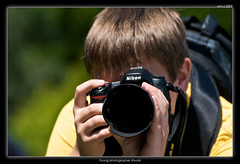Summer science camp
By Mary Bigelow
Posted on 2012-07-17
 My colleagues and I have noticed many students entering middle school have had few experiences with science investigations. We’re considering doing a summer session before school starts to engage students in science and help them learn some basic lab skills. We’re really excited about this idea, and we’d appreciate some ideas.
My colleagues and I have noticed many students entering middle school have had few experiences with science investigations. We’re considering doing a summer session before school starts to engage students in science and help them learn some basic lab skills. We’re really excited about this idea, and we’d appreciate some ideas.
–Maria from Washington
As more and more schools focus on test prep in reading and math, students have fewer experiences in subjects such as science, social studies, the arts, and physical education. For example, I talked with a high school biology teacher recently who said that his ninth graders had never planted seeds as part of an investigation of plant growth! I found that hard to believe, but he said the earlier grades had severely cut back on time for science or focused on those concepts on the required middle school science test. It’s been 11 years since the passage of No Child Left Behind (NCLB), and students in school today have been part of the test score frenzy their entire academic careers.
Your idea of giving students a jumpstart in science sounds interesting. I’ve seen schools with summer camps for literacy, math, the arts, and technology, too. These differ from traditional “summer school” in that they are not remedial in nature but rather provide students with enrichment opportunities beyond what they might have in the school year.
This isn’t something you can throw together in a few days, but you can start planning now for a future “boot camp:
- During the year, identify specific skills and experiences students may lack. Decide on your goals (keep them simple) and what kind of data will help you determine if you and the students have met the goals. For ideas, check out the 2010-11 issues of NSTA’s Science & Children journal, which has the theme “A Year of Inquiry.” Each issue focuses on a specific skill.
- Explain your goals to your principals and ask about district or school policy on summer sessions. How will the session be funded? Can you charge a small fee to cover expenses for materials and teachers’ stipends? What facilities will be available (e.g., science labs, kitchens, playground, or library)? Will you have access to the school’s technology? Can you do activities off-campus? Are there any insurance issues? Will staff such as administrators or custodians be onsite during your session? How will you recruit elementary students to participate? How many teachers and students can be involved? (I’d start small for the first time.) What are the advantages and disadvantages of full-day vs. half-day sessions? Are there other agencies or institutions that could provide support in terms of resources or personnel (e.g., science centers and museums, parks, nature centers, colleges and universities)?
- Having a theme or “big idea” for your session would help to provide a context for the activities. For example, the science of oooking would probably appeal to rising middle schoolers. This theme could incorporate concepts in chemical reactions, nutrition, measurement, basic anatomy (e.g., dissecting a chicken wing), parts of plants, food chains and webs. Other interdisciplinary science themes could include weather studies, insects, robotics, model rocketry, local geology, or water study.
- Choose activities that are planned, purposeful, and related to your goals and the theme. Even though your students are middle school, consider ideas from S&C since they are science novices. The activities should be enjoyable and engaging. Opportunities for questioning, writing, reflecting, and sketching would introduce students to journaling and science notebooks. Avoid worksheets, coloring pages, or gee-whiz demonstrations with no follow-up discussion.
- Take advantage of technology for helping students find information, create blogs, or display their work. Even something as simple as digital photography can encourage students to document their work. Create a presentation to share with your classes. For example, you could video students doing a measurement activity and use it in your classes to introduce or reinforce the concepts. Share these presentations with administrators and parents to showcase what students can do.
I heard of an interesting action research project in which teachers had a morning session with students and used the afternoons to debrief on the activities and refine them for use during the school year. They received professional development credit for this project. Another action research possibility would be to follow up on the participants during the school year. Did they apply what they learned?
Of course, not every student will be able to attend your session, so you’ll still have some students who lack basic skills. But you will have others who can demonstrate what they’ve learned and help their classmates. Good luck!
Photo: http://www.flickr.com/photos/emsi9500/3742084937/
Disclaimer: The views expressed in this blog post are those of the author(s) and do not necessarily reflect the official position of the National Science Teaching Association (NSTA).

